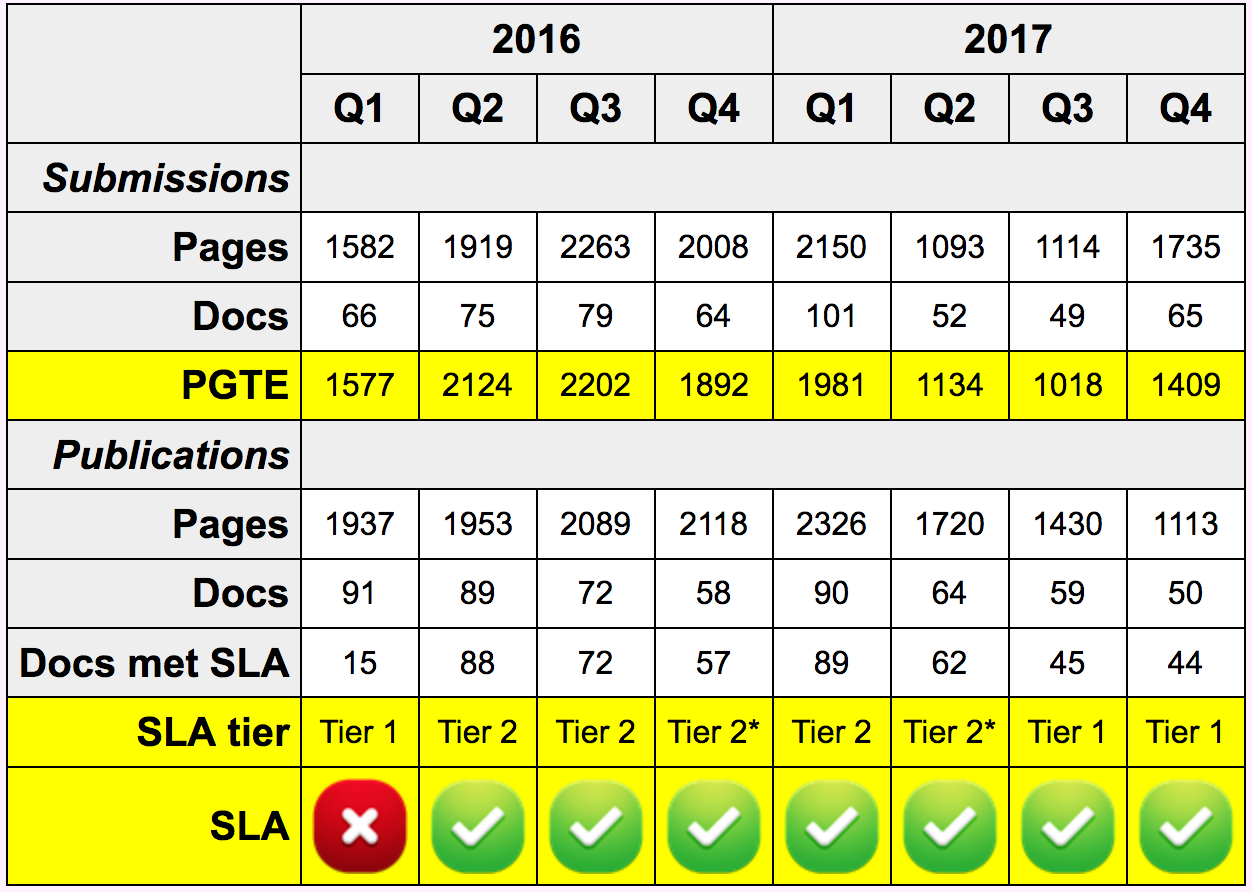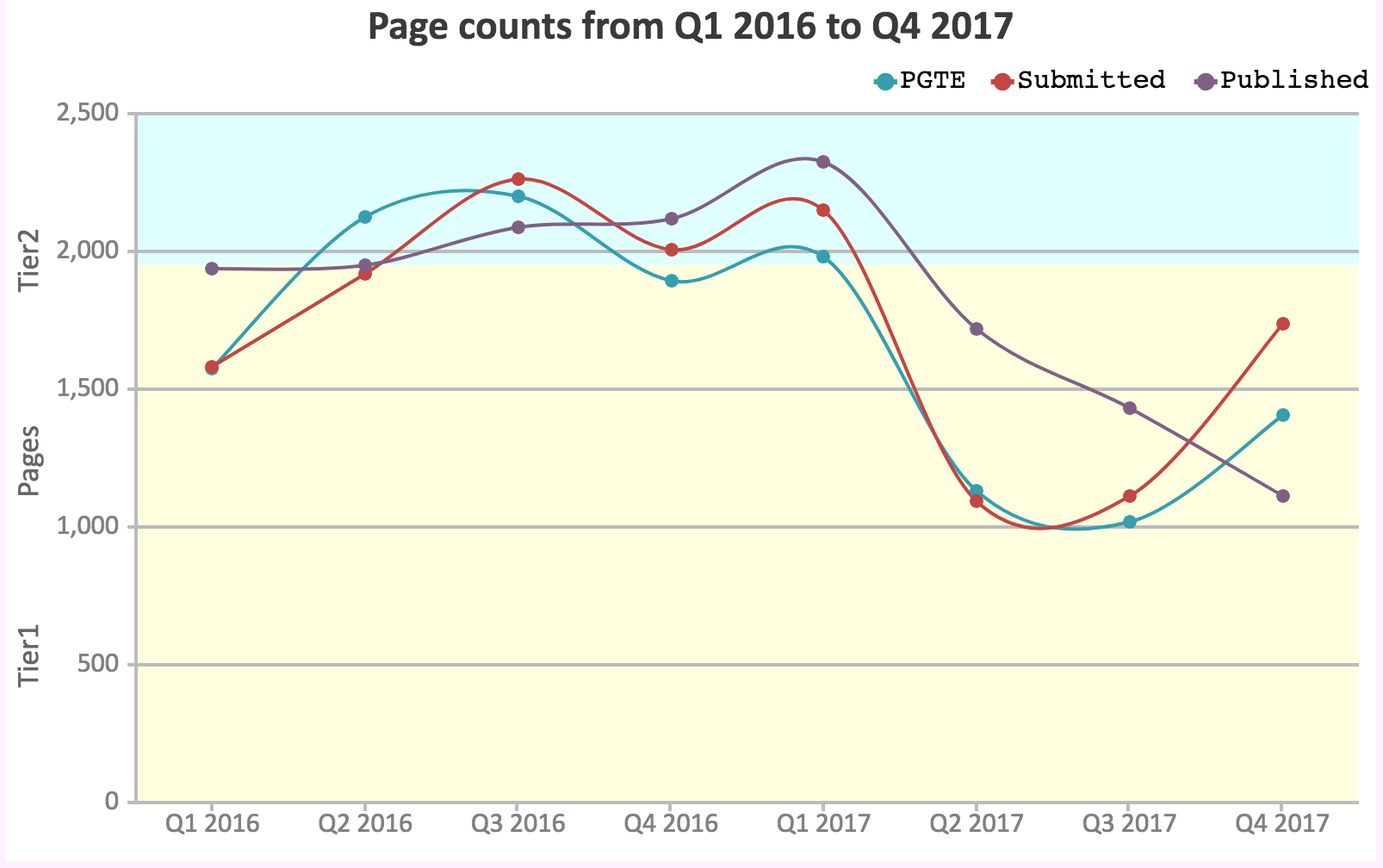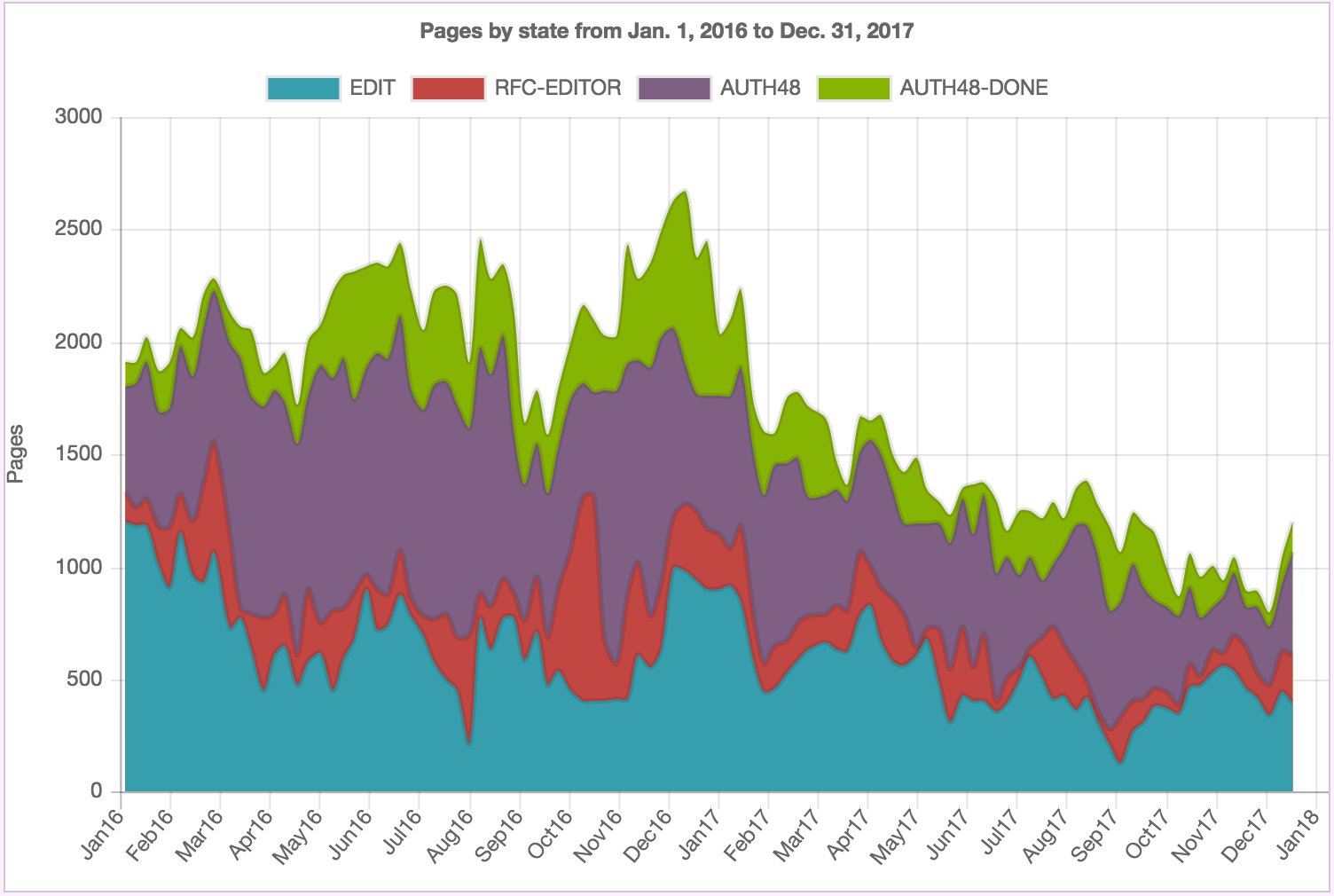Report Summary 2017
This page contains useful information regarding the performance of the RFC Production Center (RPC). It includes news items (updated as needed) and stats about production that are updated on a monthly and quarterly basis.
The RFC Editor strives to provide excellent and timely editorial service. To ensure the RFC Editor is providing the best possible service, the RPC regularly reviews its processes and liaises with the communities served. In addition, the rfc-interest mailing list is dedicated to discussing topics related to the RFC Editor.
Table of Contents
Service Level Agreement
The Service Level Agreement indicates the following:
- Tier 1: When there is a normal amount of input, the SLA is 67% of documents published within the period have an RFC Editor-controlled time that adds up to six weeks or fewer. Where ‘normal’ is defined as less than 1950 Pages gone to EDIT (PGTE).
- Tier 2: When there is a moderate burst in the amount of input, then the SLA shifts to 50% of documents published within the period have an RFC Editor-controlled time that adds up to 12 weeks or fewer within the given quarter or the subsequent quarter. Where a ‘moderate’ burst is defined as 1950 – 3072 (inclusive) Pages gone to EDIT (PGTE).
- Tier 3: When there is a large burst in the amount of input, then the SLA must be discussed and renegotiated. Where ‘large’ burst is defined as greater than 3072 Pages gone to EDIT (PGTE).
The figures below indicate whether we are meeting this goal.
“Tier 2*” indicates when Tier 2 is being applied in the “subsequent quarter” as mentioned above.
Figure 1. SLA Summary
Figure 2. PGTE and Pages Submitted & Published (by Quarter)
Figure 3. Number of Pages in Primary Processing States (i.e., no third-party holds
Note that PGTE provides a more accurate picture of the RPC’s incoming workload for a given time period (than the number of documents entering the queue).
Also note that there is a ripple effect, as spikes in document counts in any one state may be due to clusters of documents moving through the queue together. A cluster does not move to the next state until the entire set is ready to be moved. You will often see bursts in EDIT, then RFC-EDITOR, and finally PUB, as the set of documents move through the states together to publication.
Generally speaking, the more documents there are in the queue, the longer it takes for documents to move through the queue.
Notes
2017 notes: Throughout the year, 267 I-Ds were approved for publication, and 263 RFCs were published. 70% of the published RFCs had an RET of 6 weeks or less, which means the RPC met the SLA at Tier 1.
The RPC is expecting a busy and tough Q1 2018, as the IESG has indicated that there will be an increase in submissions over the next few months, as there will be some AD turnover in March 2018; there has already been a slight increase in PGTE and a more significant increase in submissions in Q4. In addition, a number of documents from Cluster 238 are expected to be released from MISSREF in the near future. The increase in submissions, along with the expected release of additional v3 tools for testing, will challenge the editors in 2018.
Q3 & Q4 2017: The RPC continues to work on their systems and tools in preparation for the transition to host multiple file formats. The editors continued id2xml testing and have started to use id2xml to generate XML files when an author-submitted source file is not available. In addition, the RPC tested how the existing system and tools handle UTF-8 and made updates where possible. The editors completed testing and worked with authors of selected documents through the AUTH48 process. The first RFCs that contain UTF-8 characters were published as follows:
RFC 8187: Indicating Character Encoding and Language for HTTP Header Field Parameters
RFC 8264: PRECIS Framework: Preparation, Enforcement, and Comparison of Internationalized Strings in Application Protocols
RFC 8265: Preparation, Enforcement, and Comparison of Internationalized Strings Representing Usernames and Passwords
RFC 8266: Preparation, Enforcement, and Comparison of Internationalized Strings Representing Nicknames
The number of pages submitted and moved to EDIT has declined since Q1 2017 (see Figure 2). The decrease in submissions allowed the editors more time to focus on testing and to prepare for the transition to new format-related tools.
The RFC Editor responded to two legal requests.
Q2 2017: In response to requests on the rfc-interest list, stable and “pretty” URLs are now available for RFC errata entries. They appear as <https://www.rfc-editor.org/errata/eidXXX>. This means that errata references can contain a URL for a specific erratum. The RFC Style Guide will be updated to incorporate the new URLs.
Tool testing related to the xml2rfc v3 format has begun. The RPC is actively testing and providing feedback regarding id2xml. In addition, the RPC is evaluating how the existing tools handle UTF-8 characters.
Q1 2017: We experienced the typical Q1 surge in document submissions associated with the March changeover in the IESG. The RPC published the largest number of pages in a given quarter within the last two years.
Authors have been highly responsive, allowing a number of documents to progress out of AUTH48 and AUTH48-DONE. This allowed a number of documents to clear the last AUTH48 hurdles and be announced as RFCs.
The editors dealt with a complicated AUTH48 for portions of Cluster 238, as reference chains were not strictly dependent on normative references, but informative also (per author request). So far this year, 36% of the published RFCs have been part of a cluster.
Q4 2016: Q4 has been quite busy, as the Format-related documents have been published, an expedited request for draft-ietf-netmod-routing-cfg has been completed, and a declaration in response to a legal request has been completed. Publications were slow in Q4, but quite a few clustered documents were stuck in AUTH48 and AUTH48-DONE (see Figure 3). Also, note that while the number of publications was low during Q4, the number of pages published was the highest this year.
For CY2016, 310 documents were published as RFCs. 58% of RFCs were published within the Tier 1 goal time; 93% of RFCs were published within the Tier 2 goal time.
Q3 2016:
There was a slightly elevated PGTE this quarter, pushing the RPC into Tier 2 for the SLA. 100% of the RFCs were published within the defined timeline — see Figure 1. 86% of the RFCs were published within the timeline defined for Tier 1. The I-Ds related to the change in RFC Format (C294) are being processed and will enter AUTH48 shortly.
Q2 2016:
As shown in Figure 4, the distribution of page counts in primary processing states has remained steady for the last four months, with AUTH48 leading for highest page count. The number of pages in EDIT is down 46% since the peak in November 2015, while the number of pages in AUTH48 has increased 35% during the same time frame.
Q1 2016:
The SLA and Work Standards associated with the RPC contract have changed. The change is significant in that it moves from reporting document counts to page counts, takes the incoming workload into consideration, and is measured on a quarterly basis. This page has been updated to reflect the new requirements set forth in the SoW and Work Standards.
The IESG requested expedited processing for the Cluster 268. C268 is 202 pages, which means it’s equivalent to 8 average-size documents.
With the Q1 PGTE finally returning to a more normal rate after 4 consecutive quarters of elevated document submissions, the RPC has managed to work through a significant portion of the queue. As seen in Figure 4, there are 53% fewer pages in EDIT and RFC-EDITOR and there are 48% more pages in AUTH48 and AUTH48-DONE since the close of 2015. In addition, processing times are coming down; the average time in EDIT and RFC-EDITOR states has decreased by 48% during Q1.
December 2015: Throughout the year, about 40% of the documents published had an RET of 6 weeks or less. Publications have been pretty steady throughout the year, with an average of 25 RFCs being announced per month. However, the submission and “moved to EDIT” rates have been bursty and have been higher than usual. For 2015, the submission count (352 documents) was the highest it’s been since 2011 (364 documents, which is the record for the RFC series). This has made it difficult to keep up with the expected processing times. See the graphs below for more details about the submission bursts and the number of documents in the various processing states.
October 2015: The RPC released the new RFC Editor website and monitored feedback. In the latter half of the month, staff prepared for IETF 94 in Yokohama, Japan.
September 2015: The legal inquiries mentioned in August were resolved with declarations (i.e., a deposition was not required). See the IAOC’s subpoenas page for details. Staff also prepared for the transition to the new RFC Editor website set to be released October 1.
As seen in the monthly document sbmissions and publications graph, there was an second influx of document submissions and documents moved to EDIT. The first surge started in January (just prior to IETF 92); the second surge started in September (just before IETF 94).
August 2015: In addition to the usual document processing, the RFC Editor has been working on responses to two legal inquiries, one of which will likely require a deposition.
July 2015: Typically, the rate of input to the queue (i.e., documents moved to EDIT) decreases following the Q1 burst; however, we have not seen the usual dip which means processing continues to be impacted.
A document legal inquiry was received, as posted on the IAOC’s subpoenas page.
June 2015: There have been and continues to be a significant number of complex clusters in play in 2015 (documents from another 3 clusters were published this month).
A document legal inquiry was received, as posted on the IAOC’s subpoenas page.
July 2015: While the graph shows just over 30 documents moving to EDIT state, the page count is equivalent to 43 average-size documents.
May 2015: We are seeing a significant impact on the RFC Editor processing times as several clusters make their way to publication. Cluster 241 (C241), the jose/oauth cluster of 9 documents, was published as well as RFCs from eight other clusters. Of the documents published this month, 58% were associated with a cluster. Processing time for cluster documents are usually longer as the editors work through consistency issues within the cluster.
While the submission rate dropped, the number of documents released into the EDIT queue was more similar to a typical submission month.
April 2015: The submission rate returned to normal in April and a couple of the smaller clusters exited the queue.
March 2015: The Q1 surge continues, as another 39 documents were released into the EDIT queue. The table above is showing the impact of the Q1 surge in submissions on the processing times. In addition, a number of large and complex clusters are making their way through the queue. Publications increased in March, as clusters C182, C184, C232, and C240 exited the queue.
February 2015: The Q1 surge continued in February, with 36 documents being released into EDIT. The RPC continues to work their way through the surge and the clusters released in January. We just missed the SLA, as 67% of the RFCs were published in 6.3 wks.
January 2015: The RFC Editor is experiencing the typical surge associated with the March IETF meeting (IESG changeover); the number of submissions has increased significantly this month. In addition, sizable clusters were released into the EDIT queue, e.g., weirds (C240), which includes 5 documents, and jose/oauth (C241), which includes 9 documents.
Other Reports
| Report | Description |
|---|---|
| Current Queue (sortable) | A list of all of the documents in the RFC Editor queue, ordered by state. (Updated dynamically) |
| Queue Summary | RFC Editor queue summary (Updated weekly) |
| Comprehensive Sub/Pub Stats | Detailed submission and publication data |
| Reports Archive | Pre-2014 reports (Was updated monthly) |
| Annual Publication Rate | Bar graph showing the number of RFCs published per year since 1969. (Updated annually). |
| RFC Editor Reports at IETF | Summary of the RFC publication process, including the state of the queue and a breakdown of the reasons for any long delays in the publication process. The report also may include recent changes in policy and improvements in tools or procedures. (Updated quarterly) |
| RFC Errata Reports | Summary of errata reports and their status, stream, and type. |
| RFC Status Changes (post-publication) | List of the RFCs whose statuses have changed since publication. (Updated as needed) |



